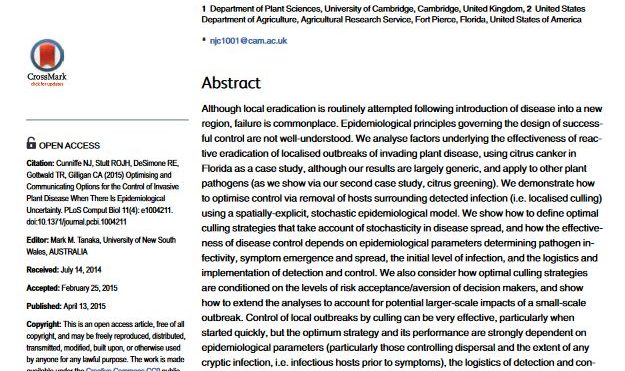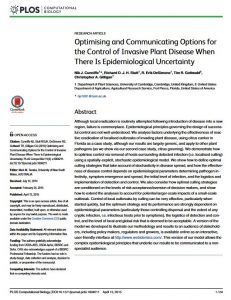Although local eradication is routinely attempted following the introduction of disease into a new region, failure is commonplace. Epidemiological principles governing the design of successful control are not well-understood. We analyse factors underlying the effectiveness of reactive eradication of localised outbreaks of invading plant disease, using citrus canker in Florida as a case study – although our results are largely generic, and apply to other plant pathogens (as we show via our second case study, citrus greening). We demonstrate how to optimise control via removal of hosts surrounding an infection (i.e. localised culling) using a spatially explicit, stochastic epidemiological model. We show how to define optimal culling strategies that take account of stochasticity in disease spread, and how the effectiveness of disease control depends on epidemiological parameters determining pathogen infectivity, symptom emergence and spread, the initial level of infection, and the logistics and implementation of detection and control. We also consider how optimal culling strategies are conditioned on the levels of risk acceptance/aversion of decision makers, and show how to extend analyses to account for potential larger-scale impacts of a small-scale outbreak. Control of local outbreaks by culling can be very effective, particularly when started quickly, but the optimum strategy and its performance are strongly dependent on epidemiological parameters (particularly those controlling dispersal and the extent of any cryptic infection, i.e. infectious hosts prior to symptoms), the logistics of detection and control, and the level of local and global risk that is deemed to be acceptable. A version of the model we developed to illustrate our methodology and results to an audience of stakeholders, including policy makers, regulators and growers, is available online as an interactive, user-friendly interface at http://www.webidemics.com/. This version of our model allows the complex epidemiological principles that underlie our results to be communicated to a non-specialist audience.
Region: Not specific
Date published:
2015
Published by:
PLOS Computational Biology
Type of resource:
Journal article
Resource topic:
Disease spread
Project/Programme: Not specific
Pest/Disease: Not specific
Pages:
24
File type:
External link (1,799 KB)




